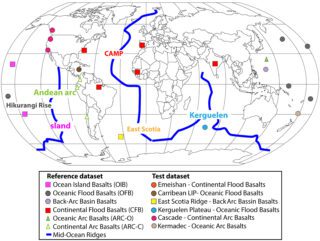Forensic Geochemistry: fingerprinting basalts
Work from the team at EDRG has applied a big data approach to the geochemical discrimination of basalts worldwide. This novel and unique chemical ‘fingerprinting’ approach has been published in an Earth-Science Reviews paper.
Basalts are ubiquitous, mantle-derived mafic rocks found within all tectonic settings. Studying the chemical composition of basalts has proven to be an effective way to understand tectonics-related mantle processes for more recent periods of Earth history when other geological and tectonic records are still well preserved. However, using basalt geochemistry to decipher ancient tectonic environments and mantle processes on Earth remains a significant challenge; interpretations are often non-unique, and weathering, erosion, and orogenic processes can modify the chemical composition of basalts, and eliminate or obscure other complementary geotectonic records. This is most apparent in the oceanic realm, where subduction-related processes have erased much of the geological record for times older than ∼200 Ma, only leaving small and rare dismembered blocks of oceanic lithosphere as ophiolite mélanges along tectonic sutures. As a result, workers must rely heavily on analyzing the chemical composition of preserved basalts to identify the tectonic settings of their original melt extraction from the mantle using various tectonic discrimination diagrams from the literature (e.g., Pearce and Cann, 1973).
In this work, it is demonstrated that such widely used classic discrimination diagram approaches often suffer from the intrinsic shortfall of large ambiguity. Instead, EDRG members have applied a big-data approach to characterize basalts generated in some typical tectonic settings, starting with a bespoke data correction and machine learning workflow. The results show that mid-ocean ridge basalts, ocean island basalts, continental flood basalts, arc basalts (from both the oceanic and continental realm), and oceanic flood basalts are statistically chemically different, thus presenting a novel and unique chemical ‘fingerprinting’ approach to more accurately discriminate basalts. The method successfully predicts the tectonic settings of basalt emplacement at a prediction accuracy of >96%.

Contact person: Dr Luc Doucet, Earth Dynamics Research Group, Curtin University.
Relevant publication:
Doucet, L.S., Tetley, M.G., Li, Z.X., Liu, Y., Gamaleldien, H., 2022. Geochemical fingerprinting of continental and oceanic basalts: A machine learning approach. Earth-Science Reviews, 233, 104192. https://doi.org/10.1016/j.earscirev.2022.104192
